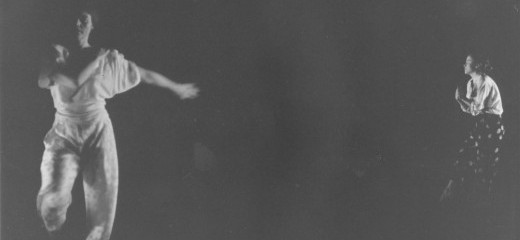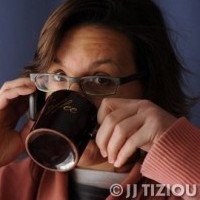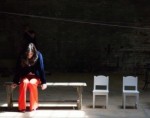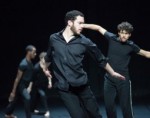
Dance 10, Looks 3?
By Anna Drozdowski
“Oh, this is so great,” exclaims a young woman as she pulls on her pre-determined dance pants, “we never get to see everyone together.” The cross section of dancers that have come out for Susan Rethorst’s second audition represents the full spectrum of the local contemporary dance landscape. People, mostly women, catch up about summer vacations, current rehearsals, haircuts; and the atmosphere feels closer to an overdue reunion than the selection process that it will soon become.Lisa Kraus*, who developed the multi-tiered project that includes the re-mounting of Rethorst’s Behold Bold Sam Dog and the latest installation of the 208 East Broadway series explains to us that there are a plethora of ways to engage beyond the audition between now and the February performances. It is a little lost on the group, who have come to see if they’re right for the roles up for offer, but gratifying to know that the project has multiple layers.
Susan arrives, a bit afluster. Her life, along with all the furniture for 208 East Broadway, now resides in Northern Liberties and she has an impending flight to Europe to teach at one of the post-graduate dance programs that she’s had a hand in starting. “Keep on stretching,” she says by way of introduction so that she can gather her thoughts. Some people do plies, others roll around on the floor, many chat up their neighbor in preparation. We will spend the next three hours following her casual tone in a “small-a” audition rather than the all-caps AUDITION that I’ve overheard nerves about.
The 35 of us gather ‘round, like school children on the carpet for story time. The room alternately pays attention with eyes, ears and fidgety limbs which want to keep moving in preparation for whatever might come next. We’re pretending patience while antsy with expectant energy. Silently present is the understanding that this is a chance to work with a long-time contributor to the form and also a well-paid opportunity to do so. “I don’t know much about her, except what I saw on Google last night” my neighbor confesses, “how has she flown under the radar for so long?”
Susan explains to the group the same things she shared with me via email when I asked if I could write about the event, given the paucity of auditions that occur in Philadelphia (a city cast with a close network of performers). More like a friend than an adjudicator, she describes her process and how much she dislikes auditions but they’re sometimes necessary—in this case both a funding obligation and because she’s new to the community. “Please remember it’s a two-way audition,” she says gesturing back and forth between the group and herself, “so please feel free to tell me if it isn’t right…you know, if it’s too slow or something.” This elicits a chuckle and then finally (finally!) we get up to start moving and learning names.
We ape a short sequence of improvised steps, trying collectively to codify the natural gestures that keep changing each time they come off of her body. We want to get it “right” and in this case “right” simply means consensus, which is a little tricky to manage with such a large group. We’re reminded about the quality of the movement, that it is also about a kind of tone in the body that is specific and not necessarily related to being a “great” dancer. The steps aren’t visibly difficult. Often gestural, the movements are subtle and focus on quality, rhythm, and commitment—all of which you can see when the group splits into smaller sections to demonstrate. This is one of the great joys of the audition process—to watch your peers perform the same challenge you’re trying to simultaneously understand; to sit on the side and silently cast the dance in your head .
The room buzzes in a silent frenzy to find someone appropriate to work with for the duet section. The steps are intentional and detailed, but not fussy or ornamental. “Not slow,” she says, “it takes the time it needs to take but not more.” There is a lot of humor as we learn the sequence in pairs, trading roles and spaces in the room for the right angle. Amidst the negotiation I reveal my writing task to a few people surprised to see me, explaining that it felt stranger for me to sit at the front than evaluate the experience from the inside. Manfred Fischbeck has snuck into the room too, his Group Motion company will host Rethorst next summer. Susan looks at the duets a few couples at a time to learn names and keep track of the clock. She is keen on us all staying in sync, partly because it is easier to watch things unfold simultaneously and (I imagine) because there is a skill about "being with" other people while still taking care of your own business, a sensitivity about timing that she’s tuning into. There is the relationship of the pairs, and the duo’s place within the group to consider. From the side we can start to see which auditionees align with the assignment, who is being polite and going through the paces, who looks at home in the movement and who is normally at ease but starting to freak out.
With half and hour left we embark on an intricate, flip-floppy phrase from the video—which makes for a jumble of limbs and varied plans of attack about how to look and learn. We’re each on our own; Rethorst hits rewind a dozen times and we pluck out thirty seconds using the tape, the mirror and fellow bodies to make 3-d sense of a 2-d example. It’s bedlam, and also an honest window into what re-creating this dance will be like as she has personally lost the movement once she gave it away to her original cast. The two-way audition, which she emphasizes again, makes more sense now…there is a transparency about what you’re getting into that lines up with our exchange about how she’d rather get to know people, know who wants to be in the room and not just spend a few hours to pick out the dancers that she’ll (literally) share her house with.
This is a sign that she’ll makes sense in our intentional community, a place she’s now calling home. That choosing colleagues is as much about the working environment as the work that is made. In this way she’s passed the Philly audition she didn’t know she was taking. Our three hours at UArts are over, our time about presence and performance quality, absorption and intention. It has felt a little like trying to make a good impression on a first date with someone who has arefined palate. A person looking for a delayed, yet committed, short term relationship. Any awkwardness is because the room is out of practice, more accustomed to being a familiar presence, or seen onstage, or approached for a specific role rather than trying to be a chameleon in a short afternoon introduction. I am reminded that dancers are a bit ageless, the 20’s-40’s in the room all have the same bags of nuts and granola bars in their bags. Neat hair-dos or lack of leotards give away where training comes from and where interests lie, who is inviting being seen, and who is stuck on getting it right. It is nonetheless lovely to dance and watch one another , on a sunny afternoon, and I suspect will be just as satisfying for those who are chosen.
Learn more about Susan Rethorst’s “Inquiring Mind/Choreographic Mind” produced by Bryn Mawr College here: http://bmcpas.blogs.brynmawr.
*Lisa Kraus is the Editor of Thinking Dance.
By Anna Drozdowski
October 11, 2012







